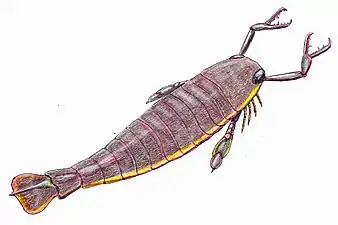Diploperculata
Diploperculata is an infraorder of eurypterids, an extinct group of aquatic arthropods commonly known as "sea scorpions". The name, derived from Greek διπλόω ("double") and operculum, refers to the distinguishing feature that unites the superfamilies included in the group, that the genital operculum is made up of two fused segments.[1]
| Diploperculata Temporal range: Middle Ordovician - Early Permian, | |
|---|---|
 | |
| Reconstruction of Jaekelopterus rhenaniae. | |
| Scientific classification | |
| Domain: | Eukaryota |
| Kingdom: | Animalia |
| Phylum: | Arthropoda |
| Subphylum: | Chelicerata |
| Order: | †Eurypterida |
| Suborder: | †Eurypterina |
| Infraorder: | †Diploperculata Lamsdell, Hoşgör & Selden, 2013 |
| Superfamilies | |
The group contains the three eurypterine superfamilies Carcinosomatoidea, Adelophthalmoidea and Pterygotioidea alongside the as of yet undescribed "waeringopteroid" clade.[2] The diploperculate eurypterine clade had prior to its description been noted as a monophyletic group of derived eurypterines that form a sister-taxon to the superfamily Eurypteroidea.[3]
See also
References
- Lamsdell, James; Hoşgör, Izzet; Selden, Paul (2013-01-31). "A new Ordovician eurypterid (Arthropoda: Chelicerata) from southeast Turkey: Evidence for a cryptic Ordovician record of Eurypterida". Gondwana Research. 23 (1): 354–366. Bibcode:2013GondR..23..354L. doi:10.1016/j.gr.2012.04.006.
- Dunlop, J. A., Penney, D. & Jekel, D. 2015. A summary list of fossil spiders and their relatives. In World Spider Catalog. Natural History Museum Bern, online at http://wsc.nmbe.ch , version 16.0 http://www.wsc.nmbe.ch/resources/fossils/Fossils16.0.pdf (PDF).
- Erik Tetlie, O; B. Cuggy, Michael (2007-09-01). "Phylogeny of the basal swimming eurypterids (Chelicerata; Eurypterida; Eurypterina)". Journal of Systematic Palaeontology. 5 (3): 345–356. doi:10.1017/S1477201907002131. S2CID 88413267.
This article is issued from Wikipedia. The text is licensed under Creative Commons - Attribution - Sharealike. Additional terms may apply for the media files.
